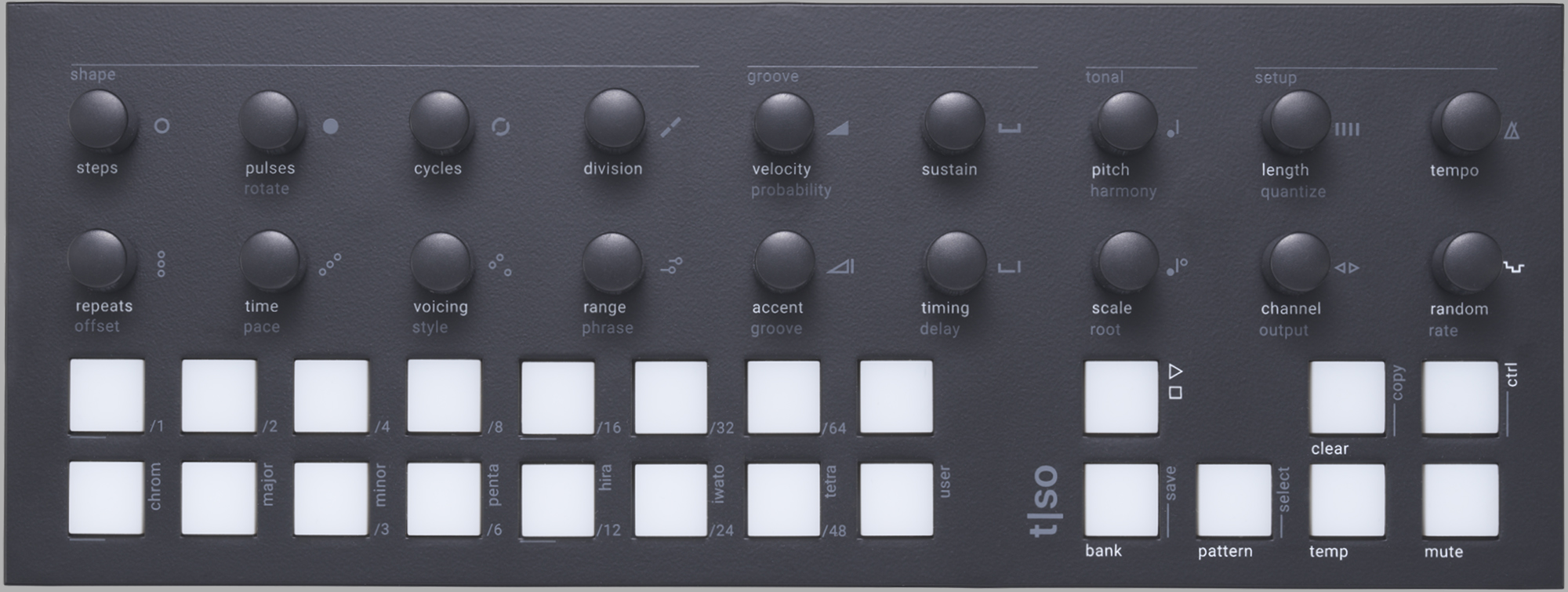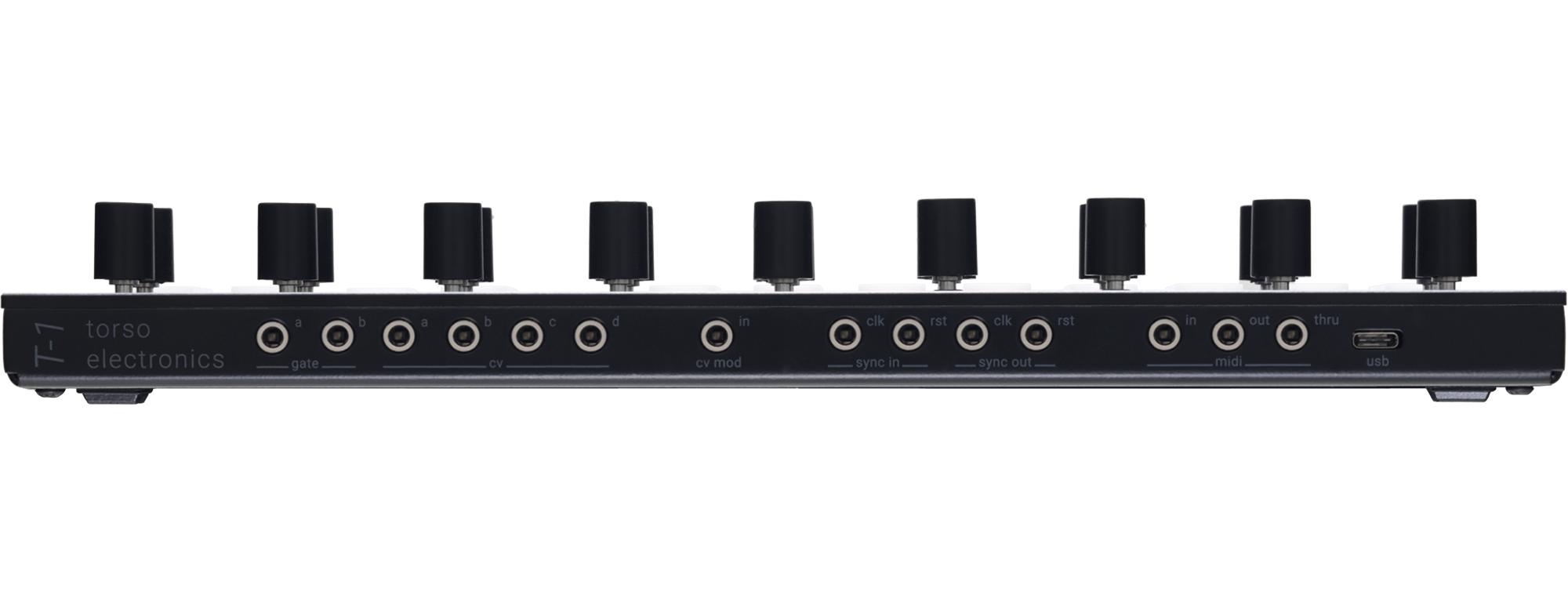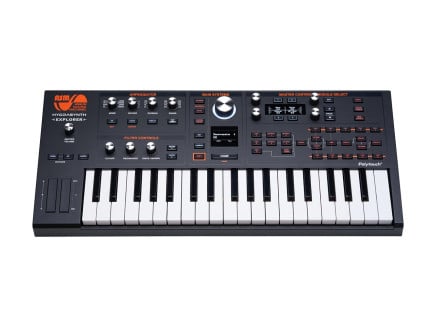Torso Electronics' debut product is the T-1 algorithmic sequencer, which aims to push the traditional role of sequencers and controllers beyond current conventions. Relatively compact and beautifully minimal, the T-1 can easily be the centerpiece of your musical world if you let it. With the ability to connect to multiple devices using deeply customizable outputs, it can control an Ableton set, MIDI hardware, and Eurorack system simultaneously. The connectivity is sensational and extensive, however, the experience of using the device is what sets it apart—shifting the way you compose and conceive of tonal as well as rhythmic organization.
By trading direct control for serendipity you open up more opportunities for inspiration to sneak in. Instead of programming notes as you would on a step sequencer, you give the T-1 tonal parameters to follow. This can mean a fair amount of button pressing and knob twiddling, but the nicely illuminated pads respond beautifully to interaction, keeping it clear what's happening at any given moment. And while there is a learning curve, it is quite gentle—and once you have the first few basics, the rest becomes very easy.
Describing something that is highly experiential is difficult: you need to feel the timing and physical gestures in your own ecosystem to truly appreciate the nuances. This device is made to be played and encourages playing by becoming an extension of you and your instrument. In this way, the device starts to influence your mind and becomes the foundation of a philosophy—a living set of ideals that evolves over time, fundamentally rooted to a core set of beliefs.
Out of the Armchair, Kant: How Does it Work?
The foundation of the T-1 is based around a Euclidean rhythm generator and algorithmic melody generator. For those unfamiliar, a Euclidean rhythmic pattern is a way of creating equidistant pulses regardless if the desired amount is divisible by the pattern's length or not. That is, if your pattern length is 16 and you want to have 9 pulses, each of those 9 pulses will be distributed as equally as possible. While this sounds confusing, the backlit 16-step grid makes it easy to understand. Adjust the Steps to the desired length (0–16), illuminate however many pulses you want in the pattern, and you've got a unique rhythm. Using the Division, Repeats and Time knobs can add interesting variation that is related to the global clock and pattern you set.
Melodic lines are generated in a satisfying manner, and when using the full 16 MIDI tracks, you can compose exceptionally deep, layered sound worlds. Using the Scale and Pitch parameters, you set the root note and corresponding scale, which limits your choice of intervals to those which are harmonically correct. By default, you have access to 7 predefined scales: chromatic, major, minor, penta, hirajoshi, iwato, and tetratonic. You can define your own scale with the last pad, letting you pick which intervals you'd like using the backlit pads. Each channel can have its own parameters—so you could, for example, keep the pads and bass limited to a pentatonic scale while keeping your leads and harmonies in chromatic or major/minor scales. This makes the T-1 capable of driving an entire ecosystem where algorithmic rules can be used to create independent behaviors on 16 channels of MIDI, up to 3 modular synth voices, or 6 trigger-based, percussive voices. The results are far from random, though: using these parameters, you can create anything from fully independent behavior to clear interconnectedness between any connected instrument(s).
The benefit of the quantized notes becomes immediately apparent when using the Voicing and Range parameters. Voicing will change the order of the notes chosen in the Pitch menu, giving you the ability to invert chords and melody lines. Using the Range knob adjusts the amount of melodic modulation that can occur, either privileging modulation that moves up in pitch, or down. Additionally, the Phrase and Style parameters give you control over how the melodies will move and evolve. Style lets you select between polyphonic chords and monophonic melody lines with the ability to have the Voicing move in inversions of the selected chords across the octaves, or sequentially, adding diatonically correct notes as it meanders through a field of notes. Rather than requiring you to specify events on a note-per-note, beat-per-beat basis, the T-1 offers you the potential to actually perform. By making a series of musical choices, you can start a chain reaction of artistic moments that are at once deliberate, yet unexpected.
Touchable
Signal has explored the history of sequencers, where we learned about a whole treasure trove of ways to program music. Early on, the original Touch Activated Keyboard from Serge was developed as a way to bring touch and gesture into the synthesis sequencing. Make Noise's Rene, Pressure Points, 0-CTRL, and the Verbos Minihorse carried on this tradition in the Eurorack format; bringing performative gesture and human touch to modular outside of a traditional keyboard or step sequencer. Recently, designs like the Touche and Linnstrument have made interfacing with computer-controlled instruments and software more tactile, while the BeatStep Pro has pushed the boundaries of pad-based controllers.

Somewhere between an alternative touch controller and a pad-based sequencer is where we find ourselves when looking at the Torso T-1. On first glance you can be forgiven for thinking this is just another pad sequencer, because in many respects it is. However, the method for interaction is where this comparison ends: the knobs are used in equal measure; they double as buttons with the pads changing their purpose—and lights—as you adjust. A temporary "Temp" button underscores the importance of physical gesture. When holding this button down, any change you make is removed when you let go of the Temp pad. This can help with creating rhythmic stutters, transposing melodic phrases, completely changing rhythm patterns, and treating the sequence as a living entity.
Use Case
How I like to use this machine is as a jumping off point for melodic and sonic exploration. Start by somewhat randomly tweaking the Steps and Pulses until you get a nice pattern, then dial-in desired settings on your synth, DAW, or Eurorack, and finally, add some melodic parameters. I usually start with single lines which you engage by using Style (CTRL + Voicing) and selecting either of the bottom two "Single" options. From there, you can add whatever notes you'd like to the pool of possibility: I usually quantize to the penta Scale and pick a Root (CTRL + Scale) at random. One thing to note is that the penta scale is a minor pentatonic scale.

From there I think it's important to think about the atmosphere and sound world you want to create. Spend time working with the voice to get a nice sound, good modulation, and then come back to the T-1 to change the Division, or add Repeats. How you use these options is unique to your own musical approach: this can be a great complex rhythm generator, or it can be a loose dream machine; it can fall somewhere in between or use both, since there are 16 channels. Whether you are strictly working with computers, MIDI hardware, modular synths, or using any combination thereof, the T-1 is easily set up to fit into your workflow.
When you have finally set up several pads, maybe around 7 or 8, you can start to actually play. The Mute and Temp buttons are your best entry into the performance realm: by using the Mute creatively, you can start to tease sections, use it as a dynamic way to play bits of a sequence, or switch between several pads simultaneously. Using the Temp pad, you can add little bits of additional sauce that will revert to the original upon release.
An artistic practice is unique to each individual, and perhaps this mindset will be helpful in your own work. Regardless, the Torso T-1 is an exceptionally unique approach to composition that feels like you are noodling around on an instrument allowing the muses to tickle you. Just like practicing a trumpet or viola, the more you sit with it the more you understand it—while, perhaps paradoxically, the less you know.













